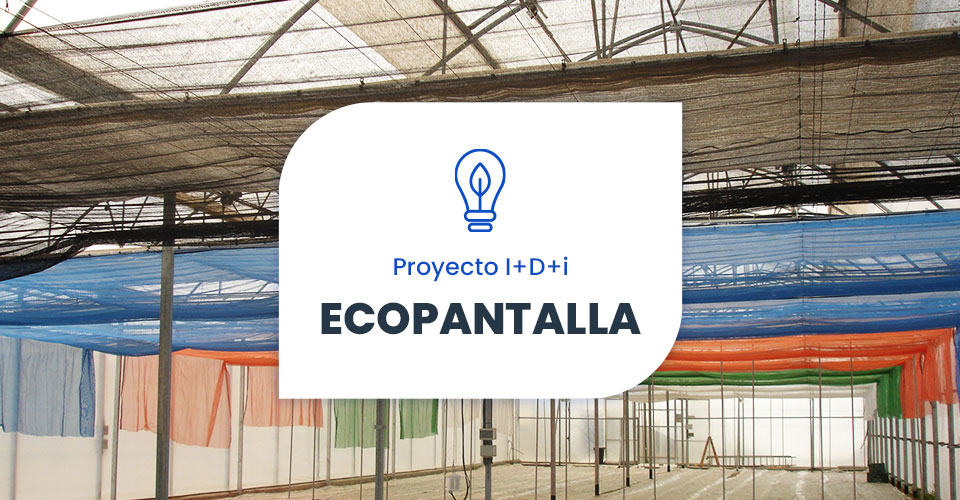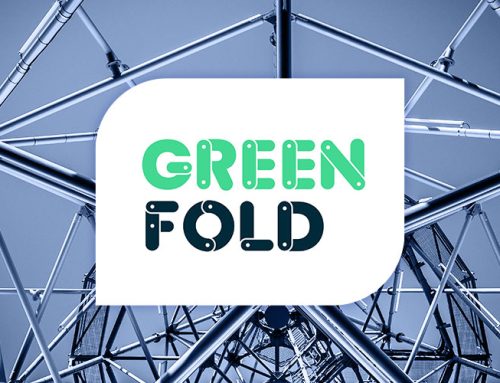ECOPANTALLA. Solar screen for greenhouses
Desarrollo de un sistema de pantalla solar de tracción rentable, rápido y fácil de montar para mejorar la gestión de la energía en los invernaderos.
The new energy manager consists of a traction system that is easy and quick to assemble, which does not require specialized personnel for its installation, thus reducing the cost of materials and installation labor.
The ecopantalla is an energy manager that regulates the amount of light that falls on the crops housed inside. In this way, it has an impact on climate control in two aspects:
 The means currently used to obtain shading in greenhouses are varied, and the technique is currently used in practices ranging from whitewashing and bleaching of the greenhouse roofs and sides, a practice still common in southeastern Spain, to extending aluminized or raffia nets over the crops.
The use of screens has been an idea imported from countries such as Holland, where shading needs are very different from those of the major production areas.
The use of these screens is mainly to save energy in heating, by retaining the mass of hot air in the lower part of the greenhouse where the plant is located, preventing its ascent to the upper parts where this heat is no longer usable by the plant.
This means that when using these same screens as shading screens, we find that there is an increase in temperature in the cultivation strip. On the other hand, this type of screens reach very considerable costs, sometimes prohibitive for the farmer.
The means currently used to obtain shading in greenhouses are varied, and the technique is currently used in practices ranging from whitewashing and bleaching of the greenhouse roofs and sides, a practice still common in southeastern Spain, to extending aluminized or raffia nets over the crops.
The use of screens has been an idea imported from countries such as Holland, where shading needs are very different from those of the major production areas.
The use of these screens is mainly to save energy in heating, by retaining the mass of hot air in the lower part of the greenhouse where the plant is located, preventing its ascent to the upper parts where this heat is no longer usable by the plant.
This means that when using these same screens as shading screens, we find that there is an increase in temperature in the cultivation strip. On the other hand, this type of screens reach very considerable costs, sometimes prohibitive for the farmer.
- Reduction of luminous intensity. Controls the amount of incident light.
- Temperature control, also reducing IR radiation, which is not visible but warms bodies.
 The means currently used to obtain shading in greenhouses are varied, and the technique is currently used in practices ranging from whitewashing and bleaching of the greenhouse roofs and sides, a practice still common in southeastern Spain, to extending aluminized or raffia nets over the crops.
The use of screens has been an idea imported from countries such as Holland, where shading needs are very different from those of the major production areas.
The use of these screens is mainly to save energy in heating, by retaining the mass of hot air in the lower part of the greenhouse where the plant is located, preventing its ascent to the upper parts where this heat is no longer usable by the plant.
This means that when using these same screens as shading screens, we find that there is an increase in temperature in the cultivation strip. On the other hand, this type of screens reach very considerable costs, sometimes prohibitive for the farmer.
The means currently used to obtain shading in greenhouses are varied, and the technique is currently used in practices ranging from whitewashing and bleaching of the greenhouse roofs and sides, a practice still common in southeastern Spain, to extending aluminized or raffia nets over the crops.
The use of screens has been an idea imported from countries such as Holland, where shading needs are very different from those of the major production areas.
The use of these screens is mainly to save energy in heating, by retaining the mass of hot air in the lower part of the greenhouse where the plant is located, preventing its ascent to the upper parts where this heat is no longer usable by the plant.
This means that when using these same screens as shading screens, we find that there is an increase in temperature in the cultivation strip. On the other hand, this type of screens reach very considerable costs, sometimes prohibitive for the farmer.
Project objectives
The development of the new energy manager for greenhouses, aims to provide the farmer with a shading system of easy profitability and fully designed for the shading function in hot areas. The power supply system for its operation is solar energy, thus promoting the use of alternative energies in the agricultural field to preserve the environment. The mesh has been specially designed for the shading function, with the presence of reinforcements to increase tensile strength during laying and removal operations, and additives with photoselective properties.Colored shading meshes
We propose to advance research on the use of shading meshes colored with a photoselective additive. With this new technology, different degrees of stimulation can be induced to provide different expected physiological responses to the ranges of solar radiation that are filtered or allowed to pass through the mesh. Solar radiation is regulated by the physical shielding, barrier effect that the photoselective netting provides. The physiological objectives sought are achieved depending on the mesh additive. Finding that: The photoselective red mesh stimulates elongation and allows for greater vegetative and generative development of the plant to achieve greater productive potential and a uniform evolutionary cycle of production. The photoselective blue mesh causes a dwarfing effect that can be interesting in indoor plants that in reaching an excessive development, not wanted, pose the problem of its large dimensions for export. The photoselective gray mesh stimulates the production of inflorescences. Compared to this type, traditional shading meshes are opaque to sunlight, acting as a physical obstacle to radiation, whatever its range, regardless of the color in which they are offered. Thus, the shading produced by them when they are only used as an element of climate control by reducing the temperature inside the greenhouse causes the unintended negative effect of reducing the photosynthesis rate of the crops. A unique product has therefore been developed to be quickly profitable for today’s agriculture.Partners
- NOVAGRIC (Novedades Agrícolas, S.A.)
- UAL (University of Almeria)
- ETIFA Technology Center
Financing
Project financed with CDTI fundsCategorías
Últimas novedades
- This Christmas, agriculture takes shape at Novagric
- HORT2THEFUTURE. Oxygen irrigation to improve soils
- HORT2THEFUTURE. Oxygen irrigation to improve soils
- GREENFOLD. Foldable and Reusable Greenhouses
- DARkWIN. Project to improve crops in the face of climate change
- +PreVENT. Positive pressure system for ecological greenhouses
- Novagric develops Solidarity Agricultural Projects
- Carbon Fertilisation Levels in Greenhouses
- How to control the climate during carbon fertilisation
- i-GROW. Protected crop management support systemtivos protegidos






